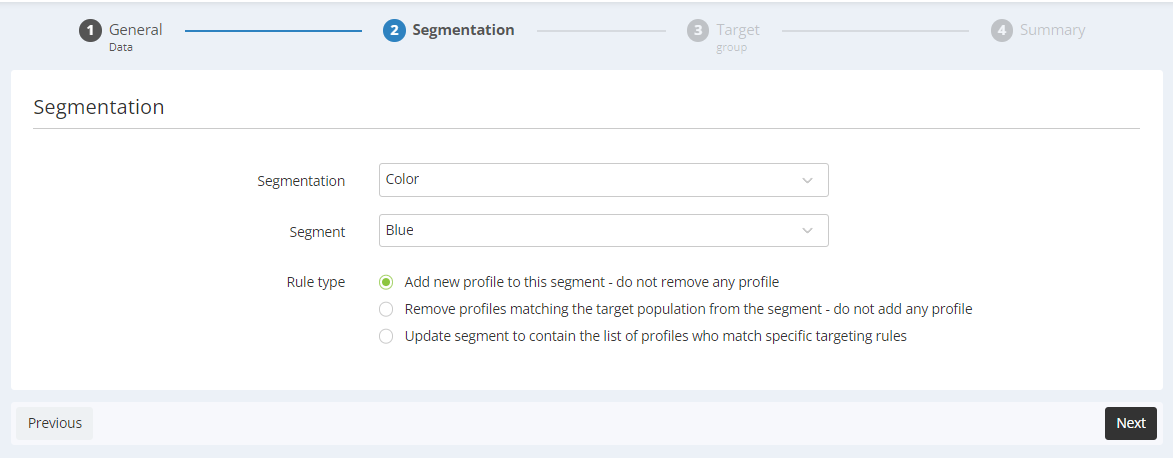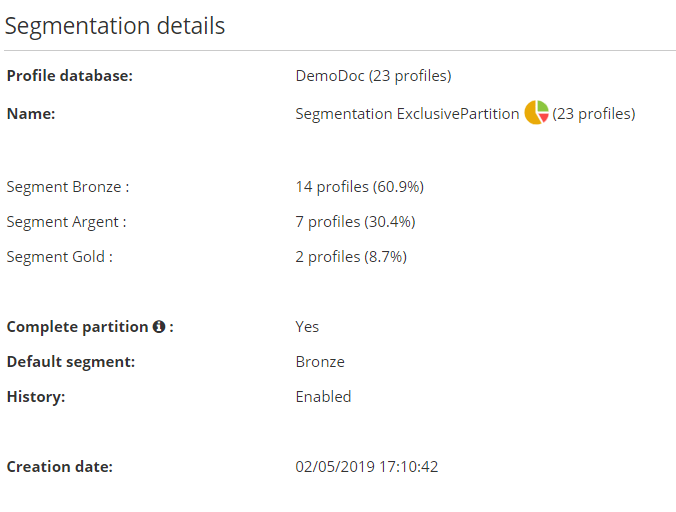Advice for Exclusive Segmentations
Choosing the proper segmentation rule
After creating a segmentation, it will be necessary to create an automatic segmentation rule if you want it to be dynamic and calculated once per day.
At the second step of creating this rule ("Segmentation"), you will have to define the action that you want to apply to profiles. Three kinds of actions are available:
-
Add: Profiles who meet the targeting criteria are added to the segment
-
Remove: Profiles who meet the targeting criteria are removed from the segment
-
Match: Profiles ending up in the segment will be exactly those matching the targeting criteria. This implies both adding profiles who meet the targeting criteria and removing profiles who no longer meet these criteria.

It can be tricky to instinctively choose the most appropriate of these actions. Indeed, the segmentation type often determines which action is the most relevant. For exclusive segmentation, a distinction is made between mandatory segmentations and incomplete (namely non-mandatory) segmentations.
Definition
Mandatory exclusive segmentation
An exclusive segmentation allows you to group profiles sharing common characteristics in a segmentation containing several segments. If it is mandatory, every profile must belong to a segment. It will therefore not be possible for a profile to be "not qualified" in a mandatory exclusive segmentation.
Consequently, a default segment will be needed. If nothing is specified at the creation of a new profile, it will be automatically added to the default segment.
For a segmentation to be "mandatory", you need to check the relevant box at step 2 (Segmentation parameters) during the creation of the segmentation.

Non-mandatory exclusive segmentation
An exclusive segmentation allows you to group profiles sharing common characteristics in a segmentation containing several segments. If it is not mandatory, it will be incomplete, which means that a profile must not necessarily belong to one the segments of the segmentation. A profile who does not belong no any segment will be "Not qualified".
It is possible to select a default segment, but this is not mandatory.

Use cases for mandatory exclusive segmentations
Recommended action: Add
The "Add" option is usually the most relevant for mandatory exclusive segmentations. Profiles will be indeed always qualified. They will be qualified for only one segment, as it is never possible to belong to more than one segment of a same segmentation.
In fact, this means that, as long as you create a rule for each segment, a profile will be always qualified for the right segment. Even though the action is called "Add", the fact that a profile can only belong to one segment means that it will be automatically removed from a segment for which it does not meet the criteria anymore.
To ensure that a profile always belong to the right segment, always define both a minimum and a maximum threshold in your targeting criteria, especially for intermediate segments.
Specific case: Match
Even though the "Match" action seems to fit the behavior described above, it is actually more appropriate in other cases.
Why?
As soon as your segmentation contains at least three segments, the issue with the "Match" action is to choose the segment towards which a profile removed from another segment will be transferred. This is especially the case for intermediate segments. With this option, it is indeed mandatory to choose another segment for profiles who do not meet the definition criteria anymore, without defining any additional rule to do so.
Yet a Silver profile can either reach Gold level... or fall to the Bronze segment.
With this option, there is a risk of multiplying profile transfers from a segment to another, without guaranteeing that the profile ends up in the correct segment.
Impossible case: Remove
The "Remove" action does not let you choose a segment towards which a removed profile will be transferred. After being removed, a profile will be "not qualified".
This entails that in the case of mandatory exclusive segmentation, in which a profile must always be qualified for a segment, using the "Remove" option is not possible.
Use cases for non-mandatory exclusive segmentations
Recommended action: Match
If your exclusive segmentation is not mandatory (and therefore incomplete), the "Match" action is the most relevant. As long as minimum and maximum threshold are specified, profiles who no longer match the criteria of the segment in which they used to belong will be transferred towards the segment in which they now belong.
In contrary to the "Add" option (see bottom of the page), by using "Match", a profile who no longer meet the criteria for the lowest segment (for example, the amount needed to reach the Bronze segment) can belong to no segment at all and therefore be "not qualified".
Even though "Match" is the most relevant action for non-mandatory segmentations, you still have to choose towards which segment a profile removed from another segment will be transferred, especially for intermediary segments. This is why we advise to favor a mandatory segmentation with 'Add' rather than a non-mandatory segmentation with 'Match'.
Rare case: Remove
In the case of exclusive segmentation, the "Remove" action does not let you choose a segment towards which a removed profile will be transferred. After being removed, a profile will be "not qualified". Therefore, there is no use case of automatic rule with the "Remove" action.
The only use of this option is therefore in case of corrections. If you find out that you created an incorrect automatic segmentation rule, you will have to stop it by clicking on the "More" button then on "Stop". You will need to create a new one afterwards. In the meantime, you can create a one-off rule to "Remove" profiles who should not be qualified for any segment. It is indeed only appropriate to remove profiles who should end up as "not qualified". If they should belong to another segment, it is quicker to directly add them to the appropriate segment.
Unadvised case: Add
If your exclusive segmentation is not mandatory, the "Add" action should be avoided: It does not let profiles leave a segment and be transferred towards "not qualified" profiles. Using this option will easily allow transfer towards a "superior" segment (bigger purchase level, higher activity...) but a profile will never be able to leave the lowest defined segment (going from Bronze to 'not qualified'...)